
The Riverside Historic District is a U.S. historic district located in downtown Evansville, Indiana. It was added to the register in 1978 and roughly bounded by Southlane Drive, Walnut, Third, and Parrett Streets. It consists of 1,010 acres (4.1 km2) and 425 buildings. It is also known as the Riverside Neighborhood.
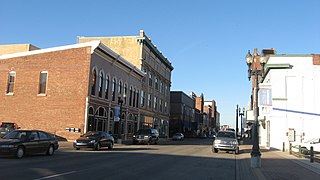
Walnut Street Historic District is a national historic district located at Muncie, Delaware County, Indiana. It encompasses 66 contributing buildings and 1 contributing object, and is located in the central business district of Muncie. The district includes notable examples of Italianate, Late Victorian, Colonial Revival, and Beaux-Arts style architecture. Located in the district are the separately listed Moore-Youse-Maxon House, Roberts Hotel, and Goddard Warehouse. Other notable buildings include the Patterson Bock, McNaughton Block (1901-1903), Mitchell Block (1909), American National Bank Building (1924), Marsh Block (1888), and the Old Post Office designed by the Office of the Supervising Architect under James Knox Taylor.

Brookville Historic District is a national historic district located at Brookville, Franklin County, Indiana. The district encompasses 682 contributing buildings in the central business district and surrounding residential sections of Brookville. It developed between about 1811 and 1913, and includes notable examples of Federal and Greek Revival style architecture. Located in the district are the separately listed Franklin County Seminary and The Hermitage. Other notable contributing buildings include the James Brown Ray House (1811-1820), Old State Bank, James N. Tyner House, Old Brick Meeting House (1810-1821), Franklin County Courthouse (1853-1859), St. Michael's Catholic Church, Howland-Farquahar-Goodwin House (1855), Valley House Hotel (1842), and the Presbyterian Church (1854-1855).

Plainfield Historic District is a national historic district located at Plainfield, Hendricks County, Indiana. The district encompasses 174 contributing buildings in the central business district and surrounding residential area of Plainfield. The district developed between about 1840 and 1959 and includes notable examples of Greek Revival, Gothic Revival, Italianate, Queen Anne, and Bungalow / American Craftsman style architecture. Notable buildings include the Ezra Cox House, Oscar Hadley House (1891), Plainfield Carnegie Library (1912), Plainfield Methodist Episcopal Church (1891), Bly Bros. Dry Goods Store, Knights of Pythias Building, Prewitt Theater (1927), First National Bank of Plainfield (1903), Mansion House Hotel (1874), Fisher's Tavern, and Quaker Meeting House (1857-1858).
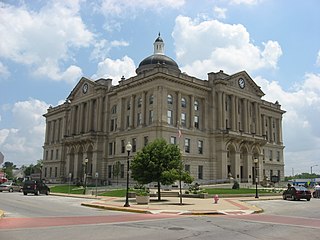
Huntington Courthouse Square Historic District is a national historic district located at Huntington, Huntington County, Indiana. The district includes 102 contributing buildings and 3 contributing structures in the central business district of Huntington. It developed between about 1845 and 1942 and includes notable examples of Italianate, Queen Anne style architecture in the United States, Romanesque Revival, Neoclassical, and Commercial style architecture. Located in the district are the separately listed Moore/Carlew Building and Hotel LaFontaine. Other notable buildings include the Hotel Huntington (1848), Opera House (1881), Lewis Block, Huntington County Courthouse (1904), old Post Office (1916), Citizens' State Bank, City Hall / Fire Station (1904), Huntington Light and Fuel Building, Our Sunday Visitor building (1926), YMCA (1929), and Huntington Theater.

Seymour Commercial Historic District is a national historic district located at Seymour, Jackson County, Indiana. It encompasses 79 contributing buildings and 4 contributing structures in the central business district of Seymour. The district developed between about 1876 and 1945, and includes notable examples of Italianate, Romanesque Revival, and Classical Revival style architecture. Located in the district is the separately listed Farmers Club. Other notable buildings include the Masonic Temple (1901), Richart Block (1900), Steinker Meat Market, Seymour National Bank, Southern Indiana Telephone and Telegraph Building (1929), Jonas Hotel, and Kidd Saloon (1887).

Edinburgh Commercial Historic District is a national historic district located at Edinburgh, Johnson County, Indiana. The district encompasses 48 contributing buildings in the central business district of Edinburgh. It developed between about 1854 and 1941, and includes notable examples of Italianate, Late Victorian and Classical Revival style architecture. Notable buildings include the Edinburgh Interurban Depot (1919), Mooney House, A. C. Thompson / Danner Building (1854), A. C. Thompson Bank (1872), Masonic Temple (1915), IOOF Building (1888), Central Hotel / Toner House (1855), and Edinburgh Town Hall (1920).
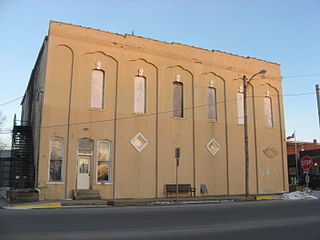
Silver Lake Historic District is a national historic district located at Silver Lake, Kosciusko County, Indiana. The district encompasses 19 contributing buildings in the central business district and surrounding residential section of Silver Lake. It developed between about 1865 and 1920, and includes notable examples of Italianate, Romanesque Revival, Classical Revival, and Early Commercial style architecture. Notable buildings include the former Enos Hotel, Municipal Building, and buildings on North Jefferson and East Main streets.

Gary City Center Historic District is a national historic district located at Gary, Indiana. The district encompasses 60 contributing buildings and 2 contributing sites in Downtown Gary. It developed between about 1906 and 1944 includes notable examples of Tudor Revival, Late Gothic Revival, and Classical Revival style architecture. Notable buildings include the City Hall and Superior Courthouse (1927), the second Gary Land Company Building, Olympic Hotel, the "Modern Apartments", Dalton Apartments, Gary State Bank Building (1929), Hotel Gary (1926), City Methodist Church, YWCA Building (1922), and former U.S. Post Office Building (1936).
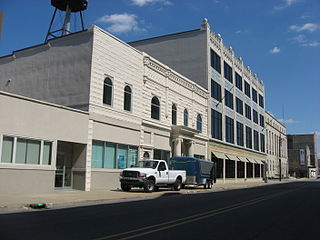
State Street Commercial Historic District is a national historic district located at Hammond, Lake County, Indiana. The district encompasses 28 contributing buildings in the central business district of Hammond. It developed between about 1885 and 1946, and includes notable example of Commercial, Classical Revival, Late Gothic Revival, and Art Deco style architecture. Notable buildings include the L. Fish Building (1927), Federal Building (1939), Lincoln Hotel (1923), Seifer Building (1925), and the Henderson Building (1902).

Hobart Commercial District is a national historic district located at Hobart, Lake County, Indiana. The district encompasses 38 contributing buildings in the central business district of Hobart. It developed between about 1869 and 1963, and includes notable example of Italianate, Classical Revival, and Art Deco style architecture. Notable buildings include the Verplank Building (1928), Orcutt Hotel and Office / Mander Building (1915), Fiester Building (1907), Fiester Building (1890-1893), Hobart Bank, Art Theater, Ben Ack Building (1926), Hobart Post Office, Roper Building / American Bank and Trust, First State Bank, Lake George Hotel / Stocker Building, Schultz Brothers Variety Store (1947), and the Kostbase Building (1950).
Hohman Avenue Commercial Historic District is a national historic district located at Hammond, Lake County, Indiana. The district encompasses 15 contributing buildings in the central business district of Hammond. It developed between about 1904 and 1956, and includes notable example of Romanesque Revival, Classical Revival, and Colonial Revival style architecture. Notable buildings include Knott's Apartments (1904), Emmerling Ambulance Garage (1918), Emmerling Building (1918), St. Joseph's Roman Catholic Church Complex, LaSalle Hotel, OK Building (1913), and the Hammond National Bank.

Franklin Street Commercial Historic District is a national historic district located at Michigan City, LaPorte County, Indiana. The district encompasses 73 contributing buildings and 1 contributing object in the central business district and surrounding residential section of Michigan City. It developed between about 1875 and 1955, and includes examples of Italianate, Gothic Revival, Queen Anne, Classical Revival, and Tudor Revival style architecture. Located in the district is the separately listed Michigan City Post Office (1909-1910). Other notable buildings include the Staiger House, Earl House, M & M Diner (1955), Zorn Building (1907), St. Paul's Lutheran Church (1876) and rectory (1888), First Federal Savings Bank, Aicher Block (1914), Brinkman Building, Trinity Episcopal Church (1889), Merchants National Bank Building (1926), Ledbetter Building (1908), Rodenbeck Saloon, First Methodist Episcopal Church (1922), Barker Hall (1929), Masonic Temple (1922-1923), and the Salvation Army Building (1925).
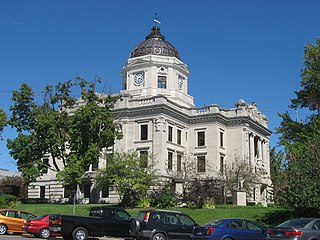
Courthouse Square Historic District is a national historic district located at Bloomington, Monroe County, Indiana. The district encompasses 57 contributing buildings in the central business district of Bloomington. It developed between about 1847 and 1936, and includes notable examples of Classical Revival, Beaux Arts and Italianate style architecture. Located in the district are the separately listed Bloomington City Hall, Monroe County Courthouse, Princess Theatre, and Wicks Building. Other notable buildings include the Federal Building, Masonic Temple, former Faulkner Hotel, Odd Fellows Building (1892), Allen Building (1907), First National Bank Building (1907), Knights of Pythias Building (1907), and Graham Hotel Building.

Farmland Downtown Historic District is a national historic district located at Farmland, Randolph County, Indiana.

Rushville Commercial Historic District is a national historic district located at Rushville, Rush County, Indiana. The district encompasses 54 contributing buildings in the central business district of Rushville. The district developed between about 1847 and 1940 and includes notable examples of Greek Revival, Italianate, Romanesque Revival, Classical Revival, Collegiate Gothic, Commercial style, and Art Deco style architecture. Located in the district are the separately listed Durbin Hotel, Melodeon Hall, and Rush County Courthouse. Other notable buildings include the former Methodist Episcopal Church (1847-1850), Church of Christ / Boys' and Girls' Club (1850-1853), Beher-King Block (1883), Presbyterian Church (1892-1893), Rushville National Bank (1911), Phoenix Lodge (1913–1915), Rushville Public Library, and former Castle Theatre (1939).

Twelve Points Historic District is a national historic district located at Terre Haute, Vigo County, Indiana. It encompasses 12 contributing buildings in a suburban commercial district of Terre Haute. It developed between about 1905 and 1954, with most built between 1890 and 1920, and includes representative examples of Commercial, Art Deco, and Classical Revival style architecture. Notable buildings include the Twelve Points State Bank (1919), People State Bank (1923), Twelve Points Hotel (1908), and Garfield Theater / Harmony Hall (1939).

North Meridian Street Historic District is a national historic district located at Indianapolis, Indiana. It encompasses 169 contributing buildings in a high style residential section of Indianapolis. The district developed between about 1900 and 1936, and includes representative examples of Tudor Revival, Colonial Revival, and Classical Revival style architecture. Located in the district is the separately listed William N. Thompson House. Other notable contributing resources include the Evan-Blankenbaker House (1901), Sears-Townsend House (1930), MacGill-Wemmer House, Hugh Love House (1930), Hare-Tarkington House (1911), Shea House (1922), and Brant-Weinhardt House (1932).

Washington Street–Monument Circle Historic District is a national historic district located at Indianapolis, Indiana, United States, covering the first two blocks of East and West Washington and Market streets, the south side of the 100 block of East Ohio Street, Monument Circle, the first block of North and South Meridian Street, the first two blocks of North Pennsylvania Street, the west side of the first two blocks of North Delaware Street, the east side of the first block of North Capitol Avenue, and the first block of North Illinois Street. In total, the district encompasses 40 contributing buildings and 2 contributing structures in the central business district of Indianapolis centered on Monument Circle. It developed between about 1852 and 1946, and includes representative examples of Italianate, Greek Revival, and Art Deco style architecture.

Shortridge–Meridian Street Apartments Historic District is a national historic district located at Indianapolis, Indiana. The district encompasses 136 contributing buildings in a predominantly residential section of Indianapolis. It was developed between about 1900 and 1951, and includes representative examples of Colonial Revival, Classical Revival, Late Gothic Revival, Mission Revival, Renaissance Revival, Bungalow / American Craftsman, and Art Deco style architecture. Located in the district is the separately listed Shortridge High School. Other notable buildings include the Vernon Court Apartments (1928), Fronenac Apartments (1951), Biltmore Apartments (1927), Meridian Apartments (1929), New Yorker Apartments (1917), Howland Manor (1929), Powell-Evans House (1911), Harms House (1906), Dorchester Apartments (1921), and Martin Manor Apartments (1916).























